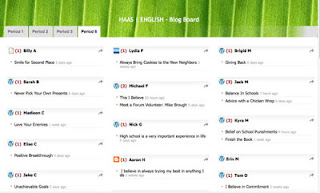Politcal Ad Project
By Regina Kilburn, HS English Teacher
The November presidential election offered an ideal time to examine how persuasive techniques are used in political advertising. Having the one-to-one computer program allowed us to combine research, writing, and production skills in a way that would not have been possible before.
We began the unit by looking at rhetorical techniques (repetition, rule of three etc.) First we identified and discussed them. Once students knew some of the techniques they were asked to find political ads (either presidential or MA senate), which used the specific techniques and identify where and to what purpose the techniques were being used. All of the necessary handouts, background materials, suggested extension work and rubrics were posted on my Moodle site as either documents or URL links.
We then expanded our investigations to consider logical fallacies. Students were given a link to the Purdue OWL (Online Writing Lab) explanation of logical fallacies and we then discussed them in class.
Next students were told to go to a presidential candidate’s own web site and choose one television ad. This they had to analyze for rhetorical/persuasive techniques and logical fallacies. They were cautioned that they were not to comment on the worth or validity of the actual claims or candidates; their job was simply to consider techniques.
The students were next asked to do the same task but with the opposing candidate. Therefore, each student would have looked at both a Romney ad and an Obama ad. The purpose of this was to show students that these techniques are universal and not confined to one side.
Students then presented each ad to the rest of the class and identified the techniques being used. This produced extremely insightful work. Students were surprised by the use of the techniques and they were pleased that they were able to identify them with some ease. Our discussions were lively and fun.
The final task was for each student to produce a similar ad for a third – fictional – presidential candidate belonging to a third – also fictional - party. Those students who had already done freshman tech seminar and/or felt comfortable using i-movie were encouraged to produce a thirty second TV ad; those who did not feel capable of making a filmed product were asked to produce a storyboard for a thirty-second TV ad. Most students chose the filmed version (using iMovie). They were asked to make an ad for a specific and identifiable audience (senior citizens, new voter, women, etc.) and to use appropriate techniques and logical fallacies. They were told they could use any images for their “president” but that they should choose a character who could appear to be of the right age, appearance etc. for their party.
Students produced very successful ads and were able to use the persuasive techniques with great skill. They clearly understood how the techniques were being used and they were able to duplicate the process.
The whole project was extremely successful. It was real learning of important skills (both in an English class and in the real world) and it was fun. It would not have been possible without the one-to-one program as we used the computers every day and for every homework.



